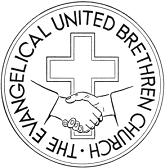
The Evangelical United Brethren Church (EUB) was a North American Protestant denomination from 1946 to 1968 with Arminian theology, roots in the Mennonite and German Reformed, and communities, and close ties to Methodism. It was formed by the merger of the Evangelical Church and the Church of the United Brethren in Christ. The United Brethren and the Evangelical Association had considered merging off and on since the early 19th century because of their common emphasis on holiness and evangelism and their common German heritage. In 1968, the United States section of the EUB merged with the Methodist Church to form the United Methodist Church, while the Canadian section joined the United Church of Canada.

Federal Hill is a neighborhood in Baltimore, Maryland, that lies just to the south of the city's central business district. Many of the structures are included in the Federal Hill Historic District, listed on the National Register of Historic Places in 1970. Other structures are included in the Federal Hill South Historic District, listed in 2003.
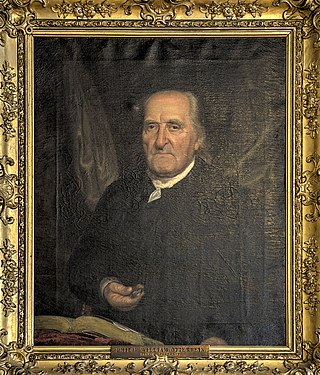
Philip William Otterbein was an American clergyman. He was the founder of the United Brethren in Christ, which merged with the Evangelical Church in 1946 to form the Evangelical United Brethren Church. That church merged with the much larger Methodist Church in 1968, forming the United Methodist Church.
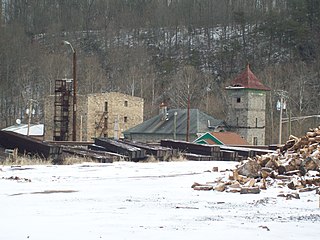
Daniels Mill is a historic mill complex located at Daniels, Howard County, Maryland, in a sheltered, wooded valley of the upper Patapsco River. The complex consists of seven early industrial structures, several concrete block and brick structures of 20th century date, and Gary Memorial United Methodist Church, a granite church built in the High Victorian Gothic style with an off-center tower entrance on the west gable. South of the church is a small cemetery.
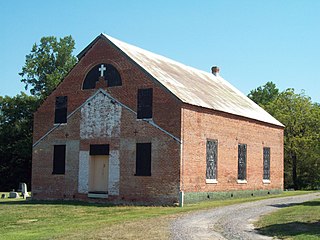
St. Mary's Catholic Church, Newport is a historic parish located in Newport, Charles County, Maryland, established in 1674. Several churches have been built on the property over its history. At present there are two churches remaining, one built in 1840, deconsecrated in 1906 and no longer used for religious services, and the current church building, built in 1954. The historic 1840 church is a rectangular brick structure, four bays in length and three bays wide. It is of simple architectural styling typical of the Greek Revival period in this locality. Located on the property is the parish cemetery, which includes the burial plot of the Brent-Merrick family, including congressman William Duhurst Merrick (1793–1857). It has several impressively scaled and ornamented monuments enclosed within a decorative mid-19th century wrought iron fence. Other memorial stones bear the signature of "A. Geddess," who founded the long-active Geddess monument firm of Baltimore in 1822.

Geeting Farm is a historic home located at Keedysville, Washington County, Maryland, United States. It is a two-story, five-bay log dwelling resting on low fieldstone foundations, with a one-story, three-bay stone addition. Numerous sheds and outbuildings are located near the house. The house was built by George Adam Geeting [1741-1812], who settled on this land near Little Antietam Creek after immigrating to the English Colony of Maryland in 1759 from his native Prussia. Geeting farmed his land and taught in a log schoolhouse nearby which became a regular preaching appointment for services held by Rev. Philip William Otterbein, one of the founding leaders of the United Brethren in Christ, the first denomination organized in the United States of America. In the mid-1770s, Geeting erected a meetinghouse which later became known as Mount Hebron Church, the first structure built expressly for services of the future United Brethren in Christ denomination. Salem United Methodist Church in Keedysville is the successor to the Mount Hebron Church and Geeting Meetinghouse. Getting himself was ordained a minister of the German Reformed Church in 1788 and traveled extensively through Western Maryland, Virginia, and Pennsylvania as an itinerant preacher. On September 25, 1800, George Adam Geeting attended the first conference of the United Brethren in Christ at the home of Peter Kemp near Frederick, Maryland. It was at this conference that the United Brethren in Christ was formally organized as a denomination and took its name. Geeting continued serving as a minister for the new church, acted as secretary of the denominational conference, and served as a bishop of the United Brethren in Christ briefly in 1812 before his death.
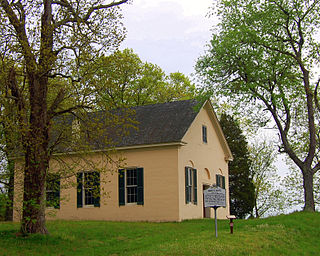
Dudley's Chapel is a historic Methodist church located at Sudlersville, Queen Anne's County, Maryland. It was built in 1783 and is a simple brick structure with a moderately pitched gable roof. A coat of stucco was added in 1883, covering all of the original brickwork. The chapel has a prominent place in the early history of the Methodist Church in Maryland. It is one of the earliest surviving Methodist churches in Maryland, and was the first Methodist church built in Queen Anne's County. Many of the prominent early leaders of the Methodist Church are known to have preached both at Dudley's including Francis Asbury, Thomas Coke, Richard Whatcoat, Jesse Lee, and Freeborn Garrettson.

Johnsville is an unincorporated community in Frederick County, Maryland, United States. It is located approximately halfway between Libertytown and Union Bridge along Maryland Route 75. The Kitterman-Buckey Farm was listed on the National Register of Historic Places in 2005.

Madison Avenue Methodist Episcopal Church, now known as Douglas Memorial Community Church, is a historic Methodist Episcopal church located at Baltimore, Maryland, United States. It is a brick, Greek Revival, temple-fronted structure featuring four fluted Corinthian columns and built 1857–1858. The rear addition is a two-story Colonial Revival style wing dating from about 1900.
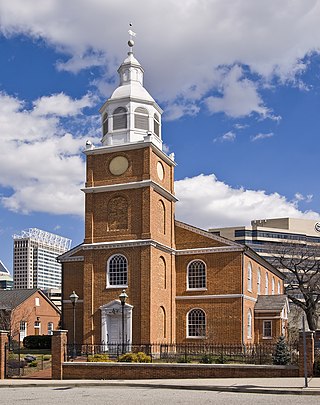
Otterbein Church, now known as Old Otterbein United Methodist Church, is a historic United Brethren church located in Baltimore, Maryland, United States. The first "German Reformed" church was built to serve the German Reformed and some Evangelical Lutheran immigrants, and later entered the Brethren strain of German Reformed Protestantism in the later Church of the United Brethren in Christ.

Orchard Street United Methodist Church, formerly known as Metropolitan Methodist Episcopal Church, is a historic Methodist Episcopal church located at Baltimore, Maryland, United States. It is a church built in a mixture of revival styles. It was constructed in 1837, with additions made in 1853, 1865, and 1882. The main church is Romanesque Revival, but the rear building is Romanesque with a large Gothic window in its northeastern facade. The nave is approximately 54 by 75 feet and features clerestory windows. The rear building is approximately 50 by 75 feet. The church was founded in 1825 by Truman Le Pratt, a West Indian former slave of Governor John Eager Howard. It now houses the offices of the Baltimore Urban League and is the oldest standing structure built by African-Americans in the city of Baltimore.

Sharp Street Memorial United Methodist Church and Community House is a historic United Methodist church located at Baltimore, Maryland, United States. It is an 1898 Gothic Revival stone structure of massive proportions. It features sharply pitched gables, a square parapeted 85-foot-high bell tower, lancet windows, and Gothic influenced interior decorative detailing. The Community House is a Georgian Revival influenced brick structure, four stories high and built in 1921. The congregation was organized in 1787 and was highly influential in the antebellum freedom movement, the establishment of the first black school in Baltimore after the abolition of slavery, and the movement to foster the institution of the African American Methodist church. It is known as the "Mother Church" of Black Methodism in Maryland. The National Association for the Advancement of Colored People, during their formative years, held their meetings at this historic church.

Mount Vernon Place United Methodist Church and Asbury House is a historic United Methodist church located at 2-10 Mount Vernon Place, Mount Vernon in Baltimore, Maryland. The church "is one of the most photographed buildings in the city, completed in 1872 near the Washington Monument on the site where Francis Scott Key died in 1843. Its sanctuary seats 900 and its rose window is modeled after the one in the Notre Dame Cathedral in Paris."

Grace-Hampden Methodist Episcopal Church is a historic Methodist Episcopal church located at Baltimore, Maryland, United States. It is a large stone building constructed in 1899. The Romanesque Revival-style church features multiple gables and a square bell tower and masonry construction utilizing local granite with round-arched openings and decorative sill and lintel courses. It was the first ecclesiastical commission of local architect George Clifton Haskell.

Lovely Lane United Methodist Church is a historic United Methodist church at 2200 St. Paul Street in the Charles Village neighborhood of Baltimore, Maryland, United States.

St. Elizabeth of Hungary is a historic Roman Catholic church complex located within the Archdiocese of Baltimore in the Baltimore-Linwood neighborhood of Baltimore, Maryland, United States.
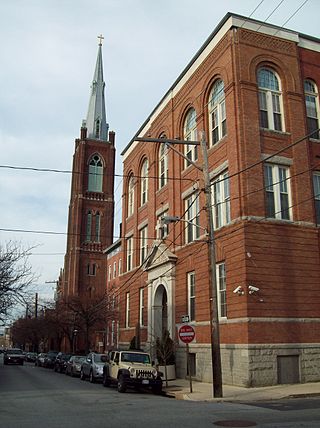
Holy Cross Roman Catholic Church is a historic Roman Catholic church complex located within the Archdiocese of Baltimore in the Federal Hill neighborhood of Baltimore, Maryland, United States.

Old Goucher College Buildings is a national historic district in Baltimore, Maryland, United States. It is an approximate 18-block area in the middle of Baltimore which developed in the late 19th and 20th centuries.

Green Spring Valley Historic District is a national historic district near Stevenson in Baltimore County, Maryland, United States. It is a suburban area of Baltimore that acquires significance from the collection of 18th, 19th, and early 20th century buildings. The park-like setting retains a late 19th-early 20th century atmosphere. At the turn of the 20th century, the Maryland Hunt Cup and the Grand National Maryland steeplechase races were run over various parts of the valley. The Maryland Hunt Cup, which began as a competition between the Green Spring Valley Hunt and the Elkridge Hunt, traditionally started at Brooklandwood, the previous home of Charles Carrol of Carrollton with the finish across Valley Road at Oakdene, at that time the home of Thomas Deford, which remains a private residence
William Ryland was a Methodist minister who served several terms as Chaplain of the Senate.
























